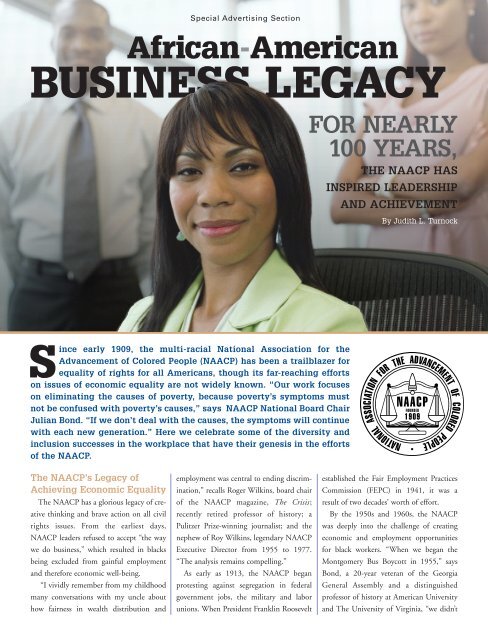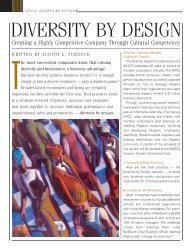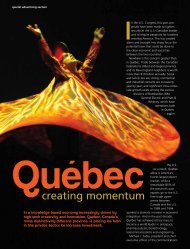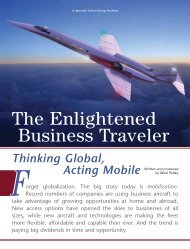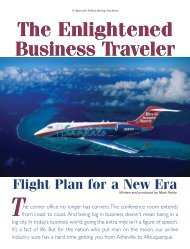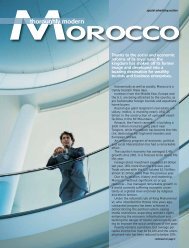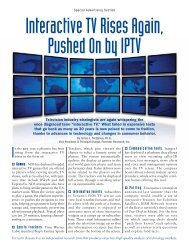African-American Business Legacy - Forbes Special Sections
African-American Business Legacy - Forbes Special Sections
African-American Business Legacy - Forbes Special Sections
Create successful ePaper yourself
Turn your PDF publications into a flip-book with our unique Google optimized e-Paper software.
<strong>Special</strong> Advertising Section<strong>African</strong>-<strong>American</strong>BUSINESS LEGACYFOR NEARLY100 YEARS,THE NAACP HASINSPIRED LEADERSHIPAND ACHIEVEMENTBy Judith L. TurnockSince early 1909, the multi-racial National Association for theAdvancement of Colored People (NAACP) has been a trailblazer forequality of rights for all <strong>American</strong>s, though its far-reaching effortson issues of economic equality are not widely known. “Our work focuseson eliminating the causes of poverty, because poverty’s symptoms mustnot be confused with poverty’s causes,” says NAACP National Board ChairJulian Bond. “If we don’t deal with the causes, the symptoms will continuewith each new generation.” Here we celebrate some of the diversity andinclusion successes in the workplace that have their genesis in the effortsof the NAACP.The NAACP’s <strong>Legacy</strong> ofAchieving Economic EqualityThe NAACP has a glorious legacy of creativethinking and brave action on all civilrights issues. From the earliest days,NAACP leaders refused to accept “the waywe do business,” which resulted in blacksbeing excluded from gainful employmentand therefore economic well-being.“I vividly remember from my childhoodmany conversations with my uncle abouthow fairness in wealth distribution andemployment was central to ending discrimination,”recalls Roger Wilkins, board chairof the NAACP magazine, The Crisis;recently retired professor of history; aPulitzer Prize-winning journalist; and thenephew of Roy Wilkins, legendary NAACPExecutive Director from 1955 to 1977.“The analysis remains compelling.”As early as 1913, the NAACP beganprotesting against segregation in federalgovernment jobs, the military and laborunions. When President Franklin Rooseveltestablished the Fair Employment PracticesCommission (FEPC) in 1941, it was aresult of two decades’ worth of effort.By the 1950s and 1960s, the NAACPwas deeply into the challenge of creatingeconomic and employment opportunitiesfor black workers. “When we began theMontgomery Bus Boycott in 1955,” saysBond, a 20-year veteran of the GeorgiaGeneral Assembly and a distinguishedprofessor of history at <strong>American</strong> Universityand The University of Virginia, “we didn’t
Advertisement 2Marsha JohnsonSenior Vice President &Chief Diversity OfficerSouthern CompanyThe Power of InclusionAt Southern Company, wework hard to provide reliablelow-cost energy, satisfy ourcustomers and bring value toour shareholders.We do this through a workforcethat is diverse, engaged andcommitted to our individual andcollective success. Our core valuesare grounded in ‘UnquestionableTrust,’ ‘Superior Performance’and ‘Total Commitment’ and providethe foundation for our businessand diversity strategy.We believe diversity and inclusionprinciples must be woveninto everything we do. Whetherworking with customers,employees, shareholders, suppliersand vendors or communities, ourgoal is to achieve superiorresults through partnerships thatdemonstrate respect, value andfull engagement. At SouthernCompany, diversity and inclusionare truly competitive advantages.To learn more, visit us at:just want rider seats in the front of the bus— we wanted the driver’s seat, too.”The work continued in the 20th centurywith the Fair Share Program, whichincreased jobs and promotions for blackworkers; Black Dollar Days, which demonstratedblack purchasing power (today at$700 billion); and the Economic ReciprocityInitiative, which annually surveys the expendituresof more than 50 major corporationson workforce diversity, corporate philanthropyand supplier diversity. “As weeducate consumers on the value of theirdollar, they will make more prudentspending decisions, rewarding businessesfor their best practices and holding themaccountable for those that need improvement,”explains Bond.In 2007, the NAACP launched itsConsumer Choice Guide, which highlightsinnovative corporate diversity and inclusionstrategies. “The NAACP is both an advocateand a valuable corporate resource,”says National Board Vice Chair RoslynBrock, who began her work with theNAACP as an elected youth representativeto the Board and serves as Director ofAdvocacy and Public Policy for BonSecours Health Systems, Inc. “Throughmutual respect, we will achieve a commongood, benefiting industry and the communityat the same time.”Just this year, the launch of Gateway toLeadership, a summer internship program inpartnership with the Money ManagementInstitute, gave another boost to studenteconomic literacy by placing <strong>African</strong>-<strong>American</strong> students at Wall Street firms andconcluding the summer experience with acase study competition.Recruitment and PipelineDevelopmentAmong the most common best practicesin diversity and inclusion are widespreadrecruitment and strong employee development.NAACP programs have long workedto increase the visibility of <strong>African</strong>-<strong>American</strong>future employees and to urge corporatesponsors to hire them. “Without sincereoutreach efforts and adoption of best practicesthat cut across racial lines in the newglobal environment, corporations will neverbe as profitable as they may hope,” saysNAACP Interim President and ChiefExecutive Officer Dennis C. Hayes. Skillbuilding, mentoring, enlightened managementpolicies and leadership developmentamong employees will build a diversepipeline to the top positions.The most successful corporations havetaken these lessons to heart, and as a result,“As we educate consumers on the value oftheir dollar, they will make more prudentspending decisions.”— Julian Bond, National Board Chair, NAACPTHE NAACP: A CENTURY OF ECONOMIC EQUITY ACTIONwww.southerncompany.com1915 NAACP protestsagainst racial stereotypingby launching anationwide boycott ofthe racist movie, Birthof a Nation.1923 Dr. W. E. B. DuBoiswrites two essays on blackseparatism as the editor ofThe Crisis magazine.
Advertisement 4Bob ReedVice President ofDiversity & InclusionAT&TAT&T’s long heritage in serving<strong>African</strong>-<strong>American</strong> communitiesstems from the company’scommitment to diversity andinclusion at every level.This year, AT&T was honored tobe included among DiversityInc’sTop 50 Companies for Diversity.The company also rankednumber one among the Top10 Companies for <strong>African</strong><strong>American</strong>s and was named as oneof the Top 10 Companies forRecruitment and Retention.Our commitment to attractingdiverse talent extends beyondAT&T’s walls. Our HBCU CampusChallenge introduces studentsfrom historically black collegesand universities to hands-on,real-world marketing endeavors,while giving them opportunities toearn scholarships for themselves andgrants for their institutions.Diversity-owned firms are vitalto our mission to deliver the bestproducts and services to ourcustomers, and AT&T spent $5.15billion with those businesses lastyear. Diversity and inclusion isalso woven into the businessstrategies for our philanthropicgiving, advertising and mediaand community outreach.AT&T is always working hard tobe an employer, business partnerand service provider of choice for<strong>African</strong>-<strong>American</strong>s, and theNAACP is a key partner in helpingus stay true to that promise.provide a wealth of growth opportunitiesfor a wide range of employees, intentionallymaking sure that diverse employees shareequally in the benefits. Examples are leadershiptraining, internal sourcing to allowbroader business perspective, internationalpostings, enlightened HR policies, mentoringprograms, and open and transparentsuccession planning. The results are seen inproducts that appeal to broader and nichemarkets, better retention rates, improvedbusiness experiences in different cultures,and diverse representation in the ranks ofupper management, the C-suite and theboardroom. These companies are positionedfor the future and already experiencingbottom line increases.Supplier DiversityNAACP programs have always supportedthe development of minority-owned businesses.Today, major corporations are selectingfrom a more diverse pool of vendors forproducts and services, resulting in significantbusiness opportunities for minority-ownedbusinesses. As proof, the elite Billion DollarRoundtable organization now has 14member companies, each of which annuallyspends at least $1 billion on products andservices from minority-owned enterprises.Its members are among the most respectedcompanies in the world, and all are reapingthe rewards of customer loyalty.Best practices for achieving the benefits ofthese new partnerships include spreadingsupplier-diversity champions throughouttheir organizations, mentoring and othersupport for the sourcing organization,establishing annual objectives and reviewingperformance against those objectives.EntrepreneurshipNAACP programs have long fostered theestablishment and growth of entrepreneurship.For example, the Reginald Lewis YouthEntrepreneurial Institute, in partnershipwith nine black colleges, has graduated2,300 high school students from its financialliteracy curriculum.The Financial Empowerment Initiative,which includes workshops on managingcredit, achieving home ownership, businessdevelopment and personal investing, isconducted regularly by NAACP branchesacross the nation.Gwendolyn Smith Iloani, founder andchair of Smith Whiley & Co., a private equityinvestment firm, and a board member ofthe NAACP <strong>Special</strong> Contributions Fundand The Crisis magazine, began attending“Without sincere outreach efforts and adoption ofbest practices that cut across racial lines in thenew global environment, corporations will neverbe as profitable as they may hope.”— Dennis C. Hayes, Interim President andChief Executive Officer, NAACPwww.att.com1944 An NAACP branch inDetroit marches in a paradefor victory over “Jim Crow.”1963 March on Washingtonto protest erosion of economicopportunities for black workers
Advertisement 6NAACP meetings as a child with herparents, and she is clear about the reasonfor her success: “I would not be where I amtoday without the work of the NAACP,and my company would not have beensuccessful without its economic andemployment agenda and its advocacy onaccess to risk-based capital.”Corporate PhilanthropyNAACP leaders have always known thatquality education is the foundation for astable and rewarding life. Explains Brock,“We have to make sure those who comethrough the corporate doors are properlytrained and ready to take on assignmentsthat lead to advancement.”This means reaching students long beforethey are of working age so they are aware ofand prepared for the opportunities. ACT-SO and “Back to School, Stay in School”are two competitive scholarship programsfor black youth that have made the dreamof education a reality for 29 years and 20years, respectively. Scholarships for graduateand undergraduate students keep the dreamalive for hundreds more every year.Many corporate foundations and givingprograms have followed the lead of theNAACP by financing self-help programs inminority communities around the country.These programs have encouraged minorityyouths to begin learning financial and businessskills starting in elementary school andcontinuing through scholarships andinternships for graduate students.“We have to make sure those who comethrough the corporate doors are properlytrained and ready to take on assignmentsthat lead to advancement.”— Roslyn Brock, National Board Vice Chair, NAACPThe Future ofCorporate Diversity“We live in a world that values evolutionand improvement, yet our country still facesmany of the same challenges we’ve facedthroughout our history,” says Bond, referringto the ever-present “color line” in society.“The NAACP is still fighting to eliminatethe racism and prejudice that feed inequalityand social ills.”There has been great progress since thebeginning of the 20th century at the urgingof the NAACP. Thanks to its continuinginspiration, committed staff and boardmembers, countless volunteers and manycorporate, nonprofit and individual partners,we’re getting closer to achieving the missionof the NAACP and creating equal opportunitiesfor all <strong>American</strong>s.■PRODUCED BY:EDITOR:DESIGNERS:Gloria LernerAlison SuttonArlette HenriquezMichael Castellano1981 Executive Director BenjaminL. Hooks and Chairman William F.Gibson sign an NAACP Fair ShareAgreement to increase jobs andpromotions for black workers.2001 Thomas W. Jones was added to FOXEntertainment’s Board of Directors, whichcompleted NewsCorp.’s commitment tothe Memorandum of Understanding.2007 Launch of Gateway to Leadership,a summer internship program with theMoney Management Institute, to placeblack students at Wall Street firms


